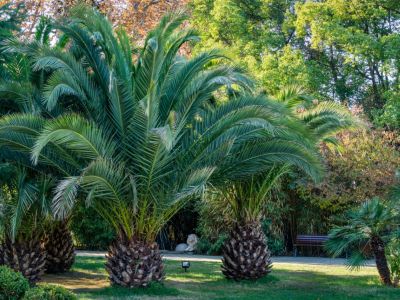Causes of Palm Tree Fusarium Wilt
Fusarium wilt is caused by the fungus Fusarium oxysporum. The two main strains are Fusarium oxysporum f. sp. Canariensis, which only attacks Canary palms, and Fusarium oxysporum f. sp. Palmarum, which is found in several ornamental palms. The disease does the most damage in plants that are in dry regions. Plants growing in cooler, wetter areas will still show symptoms but decline and die more slowly. As a rule, plants with Fusarium wilt of palms should be removed but this is a big chore in some cases. There is no Fusarium wilt treatment for palms and the disease is contagious and can infect other plants nearby. The fungus responsible for Fusarium wilt in palm trees can persist in soil for years. Spores enter plants through the roots and travel into the vascular system. Fusarium attacks the xylem, reducing water uptake. Over time it closes up the water collecting tissue with a sticky substance that the fungus produces. Gradually, the tree will show signs of stress due to inadequate water. The pathogen can also spread through mechanical means. The most common ways plants are infected is from contaminated purchased trees and from unsanitary pruning practices. Tools with the pathogen on them can introduce it during cutting. It is, therefore, extremely important to sanitize tools before using them on another plant.
Symptoms of Fusarium Wilt of Palms
Because water introduction is interrupted, the fronds or leaves of the tree are the first to display signs of infection. Just as any plant’s leaves will droop and discolor when there is too little moisture, the fronds will turn yellow and finally brown, crinkle at the ends of leaflets and eventually die. The effect usually starts at the lower or older fronds and moves up the palm. A companion disease, called pink rot, hastens the dying process in many cases. It is an opportunistic fungus which only attacks old, weak or injured plants. Fusarium wilt treatment for palms must, therefore, start with an application of Thiophanate-methyl fungicide to stem the march of pink rot.
How to Treat Fusarium Wilt
Because there is no cure for the disease, the only course of action is careful management of the tree, unless you elect to remove it entirely. Provide supplemental water and clean up infected debris immediately. Do not try to compost infected material, as spores can still survive and infest your compost heap. Prune off dying fronds but disinfect tools before using them on other plants. Do not use a chainsaw and trim on a windless day to prevent infected sawdust from drifting over to healthy specimens. Hygiene is one of the most important facets of Fusarium wilt treatment for palms. Good water and nutrient sources for the tree can prolong its life for several years.
